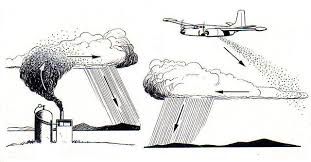Maharashtra may get Rain via Cloud Seeding - is it worth taking a chance?
Published on by Vishakha Rajput, Previous COO The Water Network at AquaSPE AG in Technology
Just two days back when Mansoon has hit the India, I also read the news about China and Maharashtra Govt talking over using Cloud Seeding in Maharashtra.
Hundreds of millions of people in India are grappling with one of the nation’s worst droughts since independence, following two years of poor rainfall and the onset of intense summer heat. Maharashtra not an exception, also facing an acute water problem.
Maharshtra also facing a deadliest drought this year, says the Govt stats . As farmers are affected by drought the most - the result is sad farmers suicides. Around 2,590 farmers across Mahrashtra have committed suicide from January to October 2015, say a Newspaper The Hindu.
What is the best way to end this Farmers Suicide chain? Better Crop - which depends on better rain.
As we all know – Artificial rain or Cloud seeding is no longer considered a rocket science and is considered an effective tool to improve rain precipitation.
The effectiveness of cloud seeding is still a matter of academic debate as some research claims the success rate is about 30% only.
Even though its not a rocket science- lets understand the Cloud seeding in a broad way – is it a attempt to change the amount or type of precipitation that falls from clouds, by dispersing substances into the air that serve as cloud condensation , which alter the microphysical processes within the cloud.
.jpeg)
Although cloud seeding remains a hugely controversial practice, both China and Russia are large-scale advocates of various delivery systems. Scientists have pointed out that weather manipulation can amplify drought conditions in one area or increase the risk of floods in another. It is an unpredictable practice at best, and often considered to be highly unreliable.
But looking at the present scenario what if Monsoon season fails to pour the required rain?
Do you think this False Rain attmept is worth taking a chance for?
Any one has some other concern or any other views on this topic ? Do share!!
Taxonomy
- Drought
- Rain Water Management
- India
5 Answers
-
Green roofs not only retain rainwater but also moderate the temperature of the water and act as natural filters for any of the water that happens to run off. The government can provide free saplings and encourage rooftop plantation. It can be initiated in government schools, colleges and offices helping the masses inculcate such environmentally responsible gestures.
-
Tulsi has tremendous environmental benefits as it purifies the air around it. Tulsi gives out oxygen for 20 hours and ozone for four hours a day along with the formation of nascent oxygen which absorbs harmful gases like carbon monoxide, carbon dioxide and sulphur dioxide from the environment.
-
We can fight climate change, pollution,poverty etc by introducing rooftop plantation all over the world.
-
Plantation in deserts will result in equal distribution of rainfall all over the world and when the dry deserts will be turned into forest ,it will serve itself as the habitat of a large number of species.
-
Yes, there should be further research to be taken in cloud seeding mechanism. If this could be practically materialized it will be boon to agricultural production by teeming the cloud for irrigation at desired places. This may reduce the need of construction of irrigation infrastructures and thus could save the millions of dollars of the nations. In this regard some positive researches are also going on at CERN, Geneva-Paris at Large Hedron Collider (LHC) experiment. I think in near future we may heard some good news regarding cloud seeding and teeming.